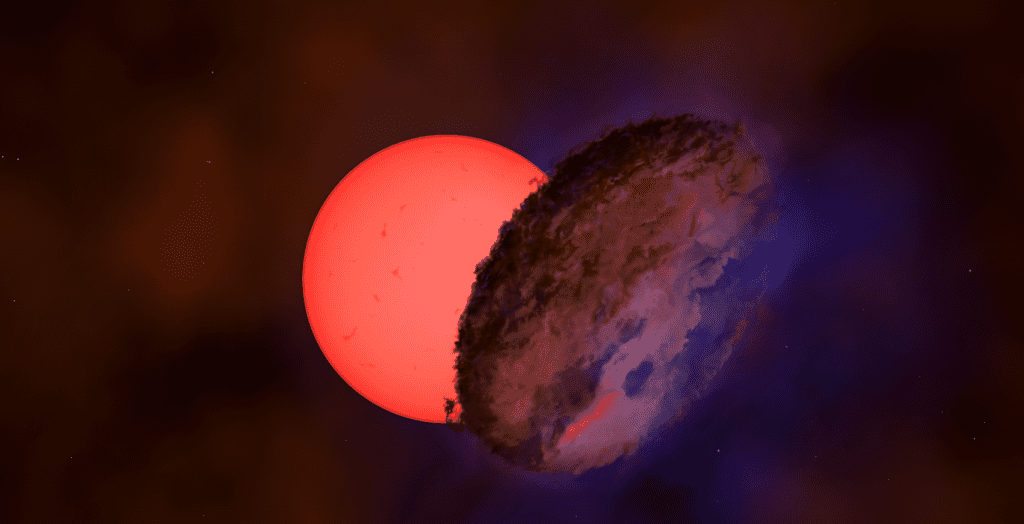Astronomers have spotted a rare giant ‘blinking’ star towards the centre of the Milky Way. The team believes the serendipitous discovery, which came after 17 years of observation, represents another example of a rare class of ‘blinking giant’ stars that represents an eclipsing binary system.
The giant star with a mass around 100 times that of the Sun–designated VW-WIT-08–was spotted by the international team of researchers as it decreased in brightness by a factor of 30. A dimming extreme enough to result in the star almost disappearing entirely from the sky.

Changes in brightness such as this are usually associated with stars that pulsate or stars that exist in a binary system and are eclipsed by their companion star.
This giant star, which is located around 25,000 light-years away from Earth, dimmed for a period of several months in 2013 and then lightened again. A characteristic not commonly associated with the dimming mechanisms listed above.
The team of astronomers that have been investigating VW-WIT-08 believe that the dimming it demonstrated eight years ago and has not repeated since is the result of an as-of-yet unseen object orbital companion eclipsing the giant star.
They add that this eclipsing object could be another star or a planet, but one thing that is fairly certain is that it is surrounded by some form of an opaque disc which is responsible for causing the star’s extreme dimming.
“It’s amazing that we just observed a dark, large and elongated object pass between us and the distant star, and we can only speculate what its origin is,” says Sergey Koposov from the University of Edinburgh.
Alongside Leigh Smith from the Institute of Astronomy, the University of Cambridge, and Philip Lucas from the University of Hertfordshire, Koposov is one of the authors of a paper detailing the discovery published in the journal Monthly Notices of the Royal Astronomical Society.
VW-WIT-08 isn’t the only example of a star dimming in this unusual fashion, but arguably it is the most extreme example discovered thus far.
What’s Going On with Giant Blinking Stars?
Another example of this form of an eclipsing binary system is Epsilon Aurigae, first discovered in 1821 by German astronomer Johann Heinrich Fritsch. The visible component of this binary system is the supergiant star Almaaz–an Arabic name meaning the he-goat–which dims by around 50% every 27 years.

Though this dimming is less pronounced than that of VW-WIT-08, it lasts for a prolonged period of time; between 640 and 730 days–around two years. This means the dimming component of this binary system must be something truely immense, probably another star surrounded by a thick ring of obscuring dust, angled edge-on from our perspective.
Whilst this two-year eclipse which last occurred between 2009 and 2011 may seem extreme, it’s topped by the eclipse seen in another similar system discovered more recently–TYC 2505-672-1 found around 10,000 light-years from Earth.
This system currently holds the record for the longest known eclipse. Every 69 years the massive star component of this system is dimmed by a magnitude of 4.5 for a period of around 3 and a half years.

Thanks to the team that found VW-WIT-08 the catalogue of these eclipsing binary systems looks set to expand as the astronomers have currently found two more giant blinking stars ripe for further investigation.
“Occasionally we find variable stars that don’t fit into any established category, which we call ‘what-is-this?’, or ‘WIT’ objects,” remarks Lucas. “We really don’t know how these blinking giants came to be.”
What Does the Future Hold for Giant Blinking Stars?
The team made the discovery of VVV-WIT-08 using data collected by VISTA Variables , part of the Via Lactea (VVV Survey) which ran from 2010 to 2016. The survey’s main mission was the observation of the Milky Way’s central bulge and southern disc in near-infrared. The project utilised the capabilities of the VISTA telescope located at the Parnal Observatory, Chile.
Lucas adds: “It’s exciting to see such discoveries from VVV after so many years planning and gathering the data.”
The dimming of VVV-WIT-08 was also captured by the Gravitational Lensing Experiment (OGLE) operated by researchers at the University of Warsaw. Our galaxy’s central bulge was also a primary target for OGLE which makes its observations in light closer to the visible range of the electromagnetic spectrum.
The main advantage of OGLE is the fact that it makes frequent observations, something that was vital for building a model of VVV-WIT-08. This combination of observations also showed the astronomers that the giant star dims in both the visible spectrum and the infrared spectrum.
The team’s findings show that there are undoubtedly more eclipsing binary systems in the Milky Way left to be discovered. But this may not be the most difficult part of the process of investigating these systems.
“There are certainly more to be found, but the challenge now is in figuring out what the hidden companions are, and how they came to be surrounded by discs, despite orbiting so far from the giant star,” Smith concludes. “In doing so, we might learn something new about how these kinds of systems evolve.”




